Do you need to take some time off work for a period that’s longer than your usual holiday allowance?
Whether it’s for personal reasons, illness or to further your education, asking for extended leave can be a tricky and nerve-wracking situation. Whatever your reasons, it’s important to stop putting off the inevitable and put in your request as soon as possible.
To help you out, we’ve put together this in-depth guide with tips and tricks on how to format your leave of absence request letter and, most importantly, get the answer you want.
What is a leave of absence letter?
A leave of absence letter can be a physical document or an email that an employee submits to their employer to request time away from work due to a big life event. As such, it is a formal letter that needs to be concise, free of errors and submitted well in advance (at least where possible) to the employee’s manager or boss.
Maintaining a professional tone is essential when writing a leave of absence letter, and so is sticking to a an easy-to-follow structure. In most cases, around three short paragraphs are sufficient to state the reason why you’re requesting time off, specifying the dates on which you’ll be away, and suggesting how the team might handle your responsibilities while you’re out of the office.
Reasons to request a leave of absence
Sometimes, life doesn’t go according to plan. Unexpected events, both good or challenging, can cause us to reconsider or shuffle around our needs and priorities so we can navigate big changes as best as possible. When that happens, a break from work can also be needed.
These are some of the most common circumstances that require employees to submit a leave of absence from work:
- Dealing with a serious medical condition
- Taking on the role of caretaker for someone in the family
- Adopting or giving birth to a child
- Continuing your education
- Relocating to a new state or country
- Going on military leave
Preparing to write your letter
Asking for leave can be a troublesome situation — after all, your employer won’t want a valued team member out for a long period of time. To make the situation a little easier for everyone involved, follow these tips:
1. Warn your employer early on
If a member of your family has a life-threatening illness, for example, let your employer know early on, as they will expect you to take time off to bereave if that relation sadly passes away. Likewise, if you know you’ll need to be scheduled in for some kind of operation, do let your manager know as soon as you do.
2. Don’t send the application without a word of warning
In order to get approval for that vacation of a lifetime or a medical leave that you badly need, you’ll have to speak with your manager before sending a formal application.
This is best done face-to-face and in private, away from your other colleagues. Send your boss an email or IM and ask for a quick chat when it’s convenient for them.
If you work in a remote setting, however, you should ask your manager to have a call with you before you put anything in writing. It’s important to keep your communication levels high and maintain personal contact.
3. Be specific
Be as transparent as possible by being honest about your time off.
If it’s to further your education, for example, make sure you explain how it will benefit the company in the long run. However, if your leave of absence is for an illness or to look after a sick family member, you don’t have to go into much detail if you do not feel comfortable doing so.
4. Discuss how your work will be handled in your absence
Let your supervisor know how you plan to distribute your work while you’re away.
You can take a plan of action with you, where you have delegated tasks to other team members that can continue those duties while you’re away. This will show that you have been proactive and that you care about your responsibilities.
5. Consider any alternatives
If you’ll still be able to work remotely during this period of time, let your employers know. This will benefit both you and them, as you will earn an income and get the work done, meaning the company won’t have to hire a temporary replacement.
Understanding your rights
Under the Family and Medical Leave Act (FMLA), certain eligible employees in the US are entitled to up to 12 weeks of unpaid, job-protected leave per year. It also mandates that employees’ group health benefits are maintained during this time.
Reasons to take FMLA leave include:
- The birth and care of a newborn child of the employee
- The placement of a child for adoption or foster care
- To care for an immediate family member (spouse, child or parent) with a serious health condition
- To take medical leave when the employee is unable to work because of a serious health condition
Bear in mind that, according to the FMLA, you’re required by law to provide 30-day advance notice in writing if your leave of absence is predictable (such as the anticipated birth of a child). In an emergency situation, however, this 30-day requirement is waived.
Depending on your contract with your employer, after a few years of working there, you should be entitled to a sabbatical (unpaid leave) for up to three months. Your allowance may vary in accordance to your company’s policies, so it’s important to check the fine print to see what your rights are before you place a formal request.
UK employees are entitled to the same benefits.
Structuring your letter
When writing a formal leave of absence letter, you must follow some formatting rules to make sure it’s presented in a clear and professional manner.
These useful points will help you create an appropriate structure:
- Sender’s address:Type in your address in the top left-hand corner of the page.
- Date:Include the date below the letterhead. If your request is via email, you can skip this part.
- Subject:If you’re sending your request by email, you should have a suitable subject line — depending on the circumstance, you could alter it or simply include something like: “Requesting Leave of Absence”.
- On-arrival notices (optional): You can also include a notation to indicate that the letter contains sensitive or confidential content. Type in your notation by using uppercase, eg: “PERSONAL” or “CONFIDENTIAL”.
- Inside address: Add in your company’s address just a few lines below the above — again, if it’s via email, skip this step.
- Salutation:Even if you’re pals with your boss, you need to address them properly in a formal letter. Open with something like “Dear Emma” or “Dear Ms Gray”.
- Opening paragraph:Start by stating the reason for your request, as well as the dates that you will be out of work.
- Body:It’s important to be as transparent as possible and explain why you need the specified days off work. This will minimize any potential conflict with your manager and it will help them understand why you have placed this request.
- Final paragraph:Here you should explain how your work will be covered in your absence, how you plan on making your departure as easy as possible (ie: with detailed notes on each project, etc) and how you can be reached in the event of an emergency.
- Closing:It’s important to close your letter with appreciation for your job and company, and to thank your boss for their consideration.
- Your name and signature: If you’re handing in a printed letter, add a handwritten signature. If you’re sending an email, simply type in your name.
Sample letters
We’ve put together a few different templates that you could follow when requesting a leave of absence.
For medical leave

To care for a sick family member
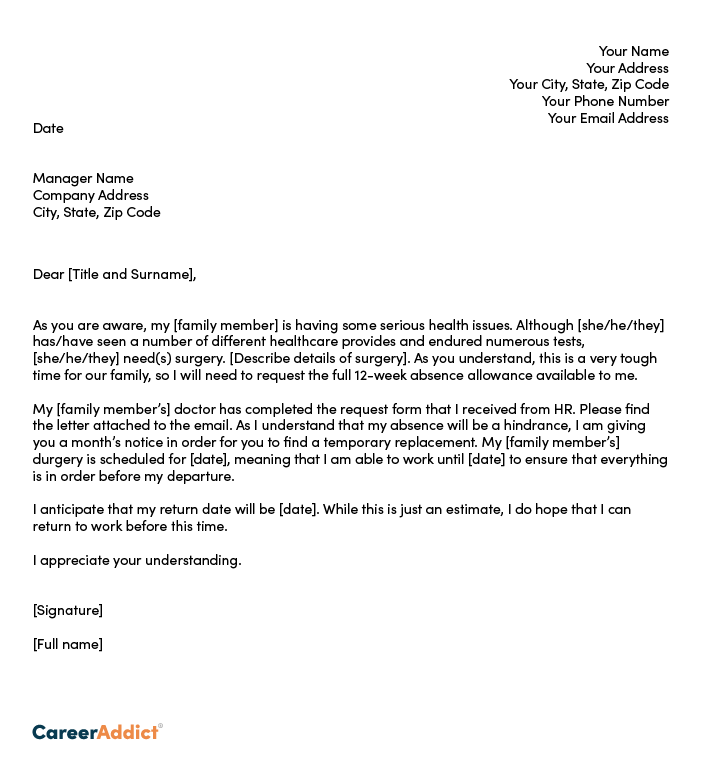
To further your education
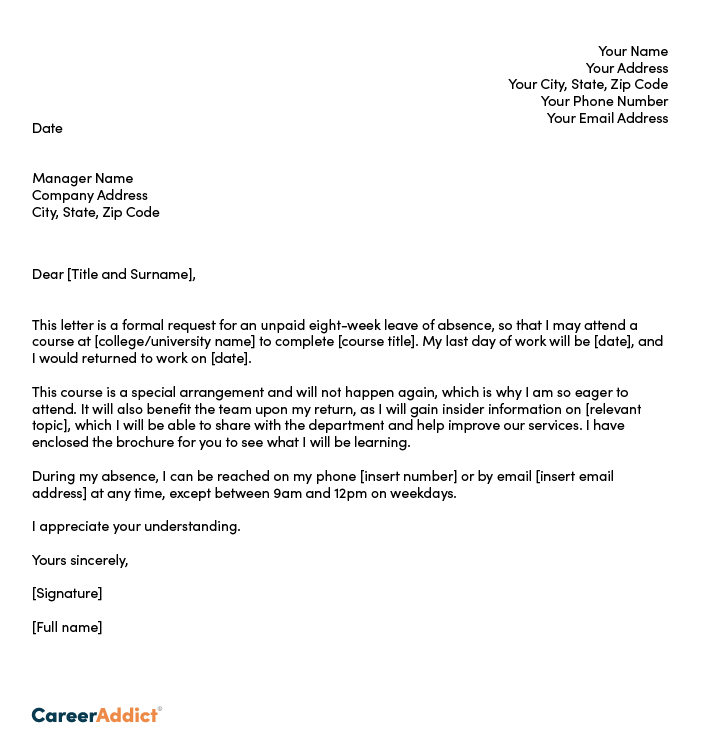
Holiday request (email)
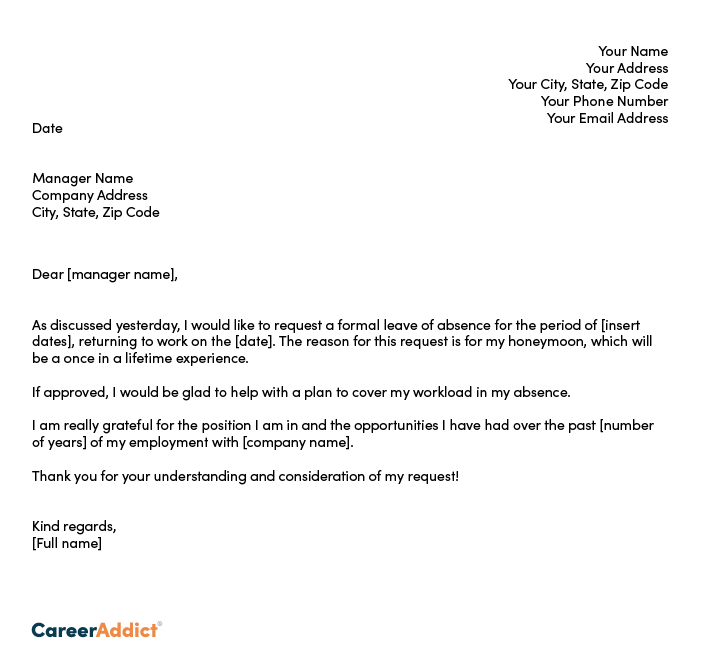
Leave for personal reasons
If you want to keep your reason private:
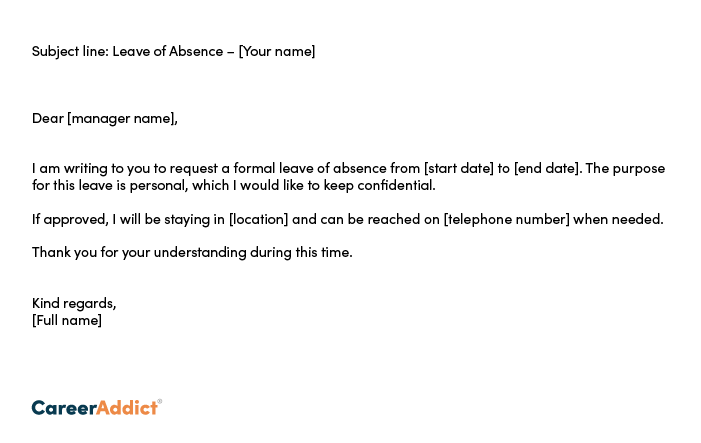
If you don’t mind sharing your reason for your absence request:

Leave for your wedding

Leave of absence letter template
If you need some help getting started with writing your leave of absence request, use our customizable template to simplify the process:
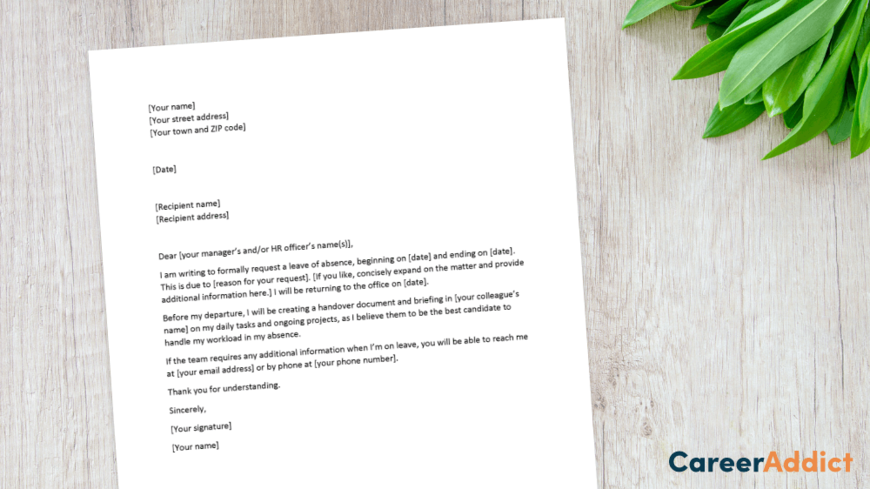
Things to remember
When it’s time to write a leave request and hand it in to your employer, bear in mind the following four points to ensure that the process goes smoothly:
1. Copy in the HR department
Remember to give a copy of your request to the HR department — they’ll need this information for your personal records. They may also be able to assist with your application, as they’ll be involved in finding a temporary replacement depending on the specific circumstances.
2. Review before you send
Be sure to proofread your request before you send it to your employer, ensuring that you have the correct information and dates, and have made valid and clear points.
3. Wait an appropriate amount of time
If you haven’t heard back straight away, don’t panic, and don’t begin to hassle your manager for an answer. Give it some time for the decision makers to deliberate before they get back to you.
4. Prepare a handover
Before leaving your job, you’ll need to think about how your tasks will be handled until you’re able to return to work. Starting as early as you can, prepare a detailed, clearly written document a colleague can refer to when taking over your tasks and projects, outlining the tools and processes you use and your deliverables.
Free checklist
To ensure that you don't forget anything in the process, save this checklist to stay organised.
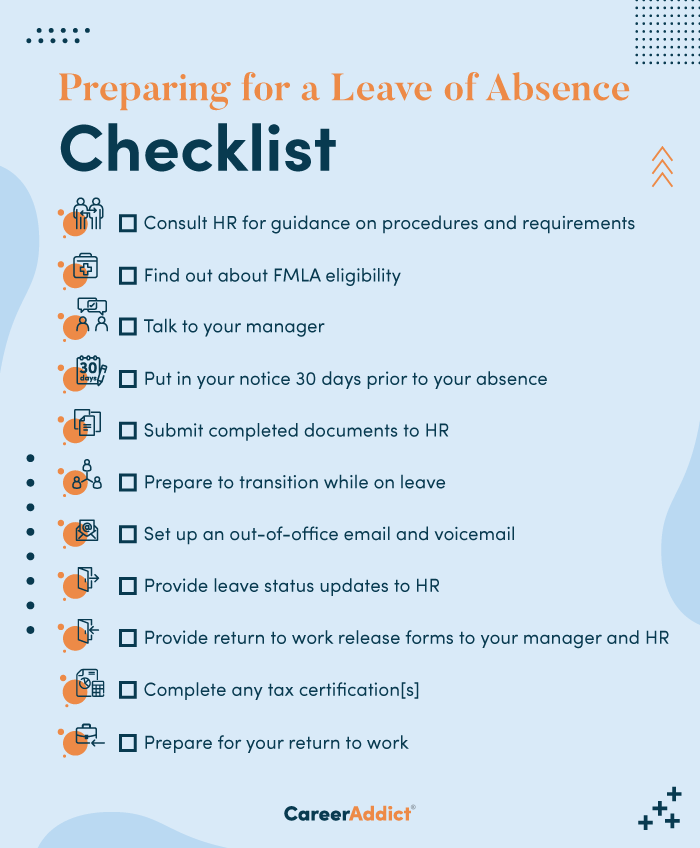
Key takeaways
Asking for an extended period of time off can be stressful, but remember that you’re legally allowed to do so if you have a valid reason. By following this guide, you’ll ensure that you do it in the most professional and considerate manner.
To summarize:
- A leave of absence request is a formal letter, and must be well structured, free of errors, have a professional tone and be submitted as early as possible.
- Leave of absence requests are submitted when employees are met with a big life event, such as the birth or adoption of a child and the need to go on maternity leave.
- When writing your letter, you must outline your reason for stepping away from the office, how long you’ll be gone for, and how your team might handle your projects in your absence.
- Check your employee handbook (if you have one) for specific guidelines on what your employer expects from you at this time.
Have you recently requested a leave of absence? If so, let us know how you placed your application in the comments section below.
Originally published on February 13, 2020. Updated by Electra Michaelidou.


